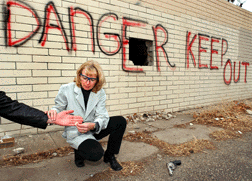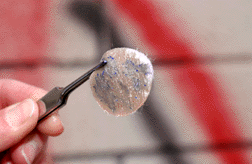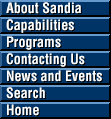FOR IMMEDIATE RELEASE
February 13, 2002
Sandia gun residue detection technique will help police ID shooters right at the crime scene
Police departments in four U.S. metro areas to try out kits this month
|

Sandia National Laboratories explosive expert Pam Walker demonstrates use of a fiberglass swab that is part of a new Instant Shooter ID Kit police officers can use to rapidly determine whether a suspect in a violent crime has recently fired a gun. (Photo by Randy Montoya)
Download 300dpi JPEG image, ‘swabdemo.jpg’, 1MB (Media are welcome to download/publish this image with related news stories.)
|
ALBUQUERQUE, N.M. — Explosives experts at the U.S. Department of Energy’s Sandia National Laboratories, working with a Colorado company, have come up with a technique that will help police officers at a crime scene quickly narrow the list of suspects in a shooting to those who have recently fired a gun.
“Police don’t have anything today that can tell them instantly whether someone has fired a gun or not,” says Greg MacAleese, CEO of Law Enforcement Technologies, Inc. (LET) of Colorado Springs. “The speed in being able to focus on a more limited array of suspects is really critical to law enforcement’s ability to solve a crime. The faster we are able to ID them, the more likely we are to convict them.”
Whenever a gun is fired, the shooter gets sprayed with an invisible blast of chemical residues that are byproducts of the incomplete combustion of gunpowder, primer, and lubricants. The Sandia-LET gunshot residue detection technique identifies very small amounts of these chemical clues on a person’s hands, arms, or clothing.
“With this technique a police officer could swab somebody right at the crime scene and have a reading in seconds,” says Sandia principal investigator Pam Walker.
LET licensed from Sandia the chemical detection technique that makes the kits possible. The company is marketing the kits under the name “Instant Shooter ID Kit.”

Spots where gunshot residues are present turn blue against the white swab after 40 to 60 seconds. (Photo by Randy Montoya)
Download 300dpi JPEG image, ‘blueswab.jpg’, 296K (Media are welcome to download/publish this image with related news stories.)
|
|
The first 2,000 gunshot residue detection kits are being tested with police departments in New York state and the Los Angeles, San Diego, and Phoenix metro areas beginning this month, says MacAleese.
Chemical clues
In laboratory and live-fire trials at Sandia the technique was effective in determining if someone had recently fired a gun, regardless of whether the shooter had washed his or her hands after the shooting. Various gun and ammunition types were used.
Each LET gun residue detection kit includes a round fiberglass swab that can be rubbed on the hands, arms, or clothing of someone suspected of firing a gun. The police officer places the dry swab into a small plastic cube, pushes a plunger button on the lid that breaks a vial inside the cube to release a clear liquid, which soaks the swab.
If gun residue is present, spots where trace amounts of organic residues are present turn blue against the white swab, typically in 40 to 60 seconds.
“We routinely do trace detection of explosives in the lab,” says Walker, “so we thought why not take this technique and make it a product that can help keep our streets safer.”
Roughly the size of a cassette tape, each LET kit should cost less than $20, according to MacAleese.
“We’d like to see these kits not only in every forensics lab and violent crime unit but also in every squad car in the country,” he says.
Positive results from the kits could be used to influence a suspect to confess or implicate other suspects. In addition, the same swab used at the scene can be sent to a forensics lab for additional chemical analyses, the results of which could be used as evidence in court, he says.
First 72 hours
Police officers investigate some 13,000 firearm homicides in the United States every year, and approximately 40,000 patients with gunshot wounds resulting from assault are treated in U.S. emergency rooms annually, according to 1997 statistics from the U.S. Department of Justice.
Detectives know the first 72 hours are the most critical time for the successful investigation of a crime, says MacAleese. Every minute a shooter stays out of police custody is a minute he or she can spend destroying evidence, establishing alibis, or leaving town, he says.
Prior to founding LET MacAleese worked in law enforcement for 14 years. While at the Albuquerque Police Department as a violent crime detective, he pioneered the CrimeStoppers program, now an international program in more than 1,000 communities worldwide.
Sandia is a multiprogram laboratory operated by Sandia Corporation, a Lockheed Martin Company, for the United States Department of Energy under contract DE-AC04-94AL85000. With main facilities in Albuquerque, N.M., and Livermore, Calif., Sandia has major research and development responsibilities in national security, energy and environmental technologies, and economic competitiveness.
Media contact:
John German, jdgerma@sandia.gov, (505) 844-5199
LET, Inc. media contact:
Bill Lockwood, blockwood@lawenforcetech.com, (719) 380-5557
|
